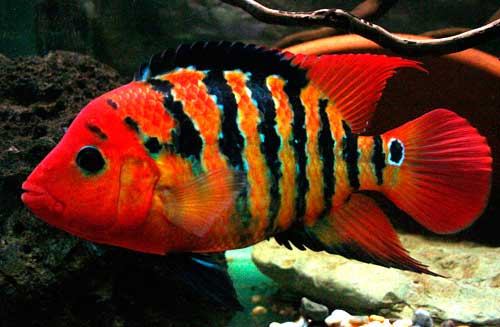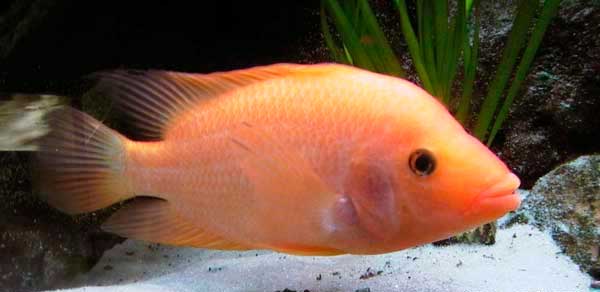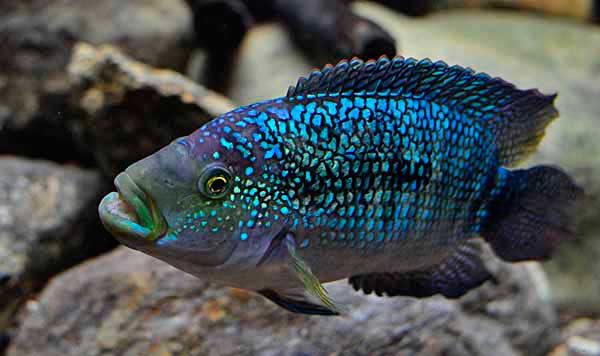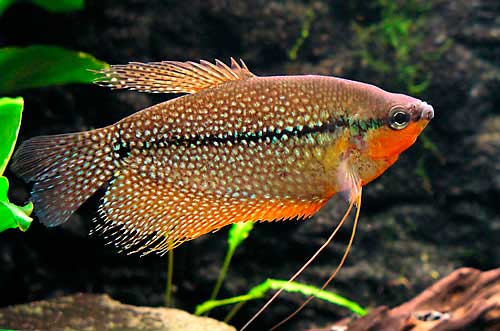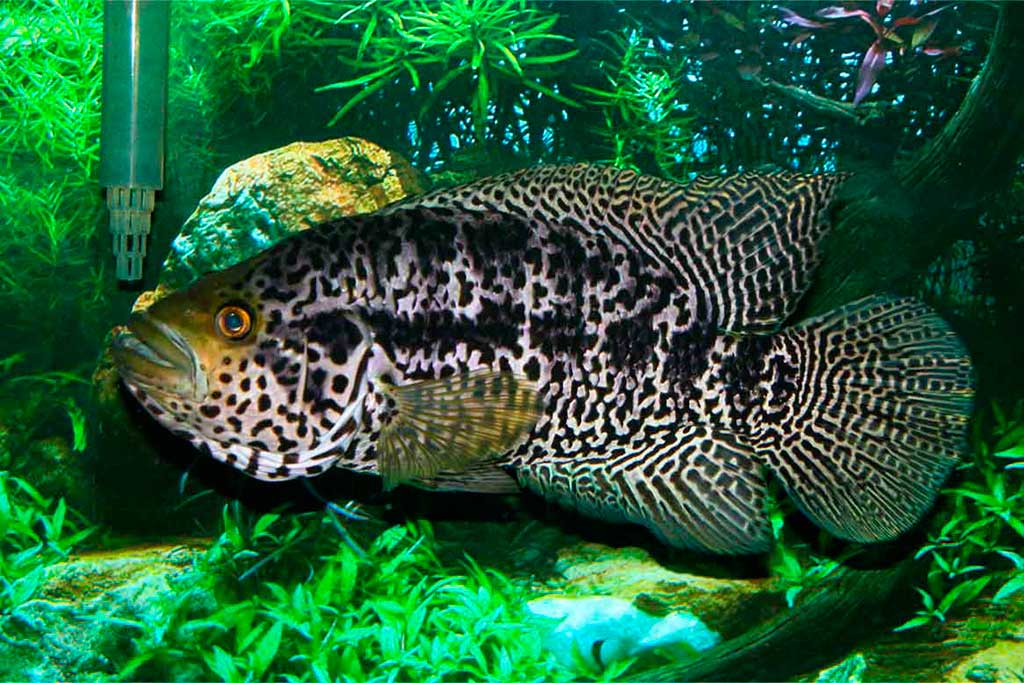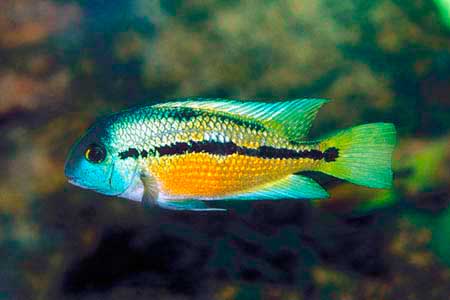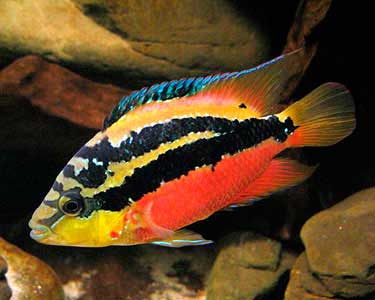Cichlasoma Festa gets its species name in honor of its discoverer Enrico Festa. Its other name, orange cichlasoma, is for its predominant coloration, which becomes especially bright during spawning. Amateurs first became known only around 1977. It quickly became a popular inhabitant of aquariums around the world, in spite of its inhospitable temperament and the need for a large body of water for its content. The reason for this unusually beautiful coloration and pronounced individual features of behavior.
| kingdom | Animals |
| type | Chordates |
| class | Radial fish |
| division | Perch |
| Family | Cichlids |
| genus | Cichlasoma |
| Species | Cichlasoma festae |
Synonyms: Orange cichlasoma, Amphilophus Festae, Cichlasoma festae, Heros Festae, Nandopis Festae
Cichlasoma festa, where do they live?
In nature, the Festa cichlasoma inhabits the waters of the western slope of South America, from the Rio Tumbes Basin to the Rio Esmeraldas River within Ecuador.
Cichlasoma Festa Description
Orange cichlasoma is a large, predatory, aggressive, territorial fish. In the wild, the body length of the male reaches 35 – 40 centimeters. In the female up to 25 – 30 centimeters. In aquarium keeping the body length of the male, as a rule, does not exceed 20 centimeters, the female up to 15 centimeters. The body is moderately elongated, high flattened from the sides. The head is large with large eyes, a terminal mouth bordered by thick pink lips. The male has a fatty tubercle on the forehead. The male has a golden orange coloration, which changes to greenish during the spawning season.
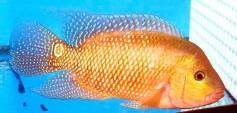
Its unpaired fins are colored wine-red. Shiny blue dots are scattered all over the body. The female is colored bright orange tones, she has on the sides of 7 transverse stripes velvet black. At the base of the caudal fin there is a black spot with a pearlescent border. The stiff rays of the dorsal and anal fins are colored blue-black. The male also has all these stripes and dots, but they are expressed so weakly that it is difficult to see them. During spawning, these stripes become more noticeable.
Образование пары
Predominantly found in the middle and lower aquatic horizons. Sexual maturity is reached at a body length of at least 15 centimeters at the age of 14 – 16 months. Marital pairs are formed from the fry age, which makes it necessary to purchase a flock of 10 fish C. Festa. Festa, and after the formation of a pair of other fish to drop off and give in good hands. It is easier and better, perhaps, when buying carefully observe the fry to immediately buy an allied pair. Although this is not always possible. In addition, you can easily make a mistake. The surest way is probably to negotiate with a seller who values his reputation. He has time to observe the fish to accurately determine the established pairs. Although this service will cost you some extra money, but in the future will save you from many surprises.
Cichlasoma festa Sex differences
It is easy to distinguish individuals by sex in this species by size and coloration. During the spawning period, the producers have anal tubercles – the male has a pointed one, and his girlfriend has a truncated pyramidal tubercle. The male loses its orange coloring, changing it to greenish shades. But there’s little use for this simple sex determination. Because pairs capable of producing offspring are formed from the age of fry. Attempts to get offspring from unfamiliar fish have positive results far from always.
Cichlasoma festa Aquarium keeping
The complexity of the content is determined by the space you have available. Ц. Festa territorial, aggressive fish. Its aggressiveness is expressed less in reservoirs in which one fish is about 200 liters of water. If you have where to put an aquarium of suitable capacity, then the rest of the conditions you can create for her without much trouble.
Aquarium volume
As mentioned above, one pair of Ts. Festa needs an aquarium of about 400 liters. And it should be a couple formed from the fry age – favorable to each other cavalier and lady. If you do not have such a pair, but still want to plant your pet girlfriend to do it very carefully, gradually.
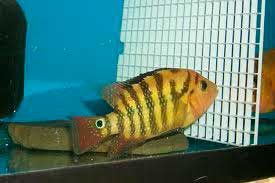
First, it is necessary to divide the aquarium glass or mesh into two parts, then place the fish on opposite sides of this barrier, which can be removed only after the fish get used to each other. It should be noted that this method does not always give positive results.
Грунт
Like all members of the genus Cichlasoma Festa likes to dig the soil, dig up plants and generally engage in landscaping. Therefore, it is better to use granite crumbs or small pebbles for the ground. At the bottom it is necessary to arrange several rocky archipelagos dividing the water body into several territorial zones. Also from large stones should be built several grottoes and caves. All these constructions will help your pets to be secluded, when they are tired of society and want to be alone to deal with their own thoughts (well, about the meaning of life, for example, to think, meditate…). All this will prevent nobody needs squabbles and scuffles. Also on the bottom in different territorial zones should be put a few flat stones or other objects with a flat surface. These objects will serve as a substrate for spawning, if it comes to that.
Festa cichlasoma and aquarium plants
Quite often recommended in a pond with these fish to do without live plants at all. I think this is not quite right. After all, your aquarium is a corner of LIVING nature. Therefore, it is worth at least trying to decorate it with live flora. Of course, all plants should be planted in pots. Which are buried in the ground, and then masked to your taste. Hardy plants with a strong rhizome should be chosen, preferably fast growing. You can and should try vallisneria, elodea, large species of cryptocoryne, echinodorus. Thickets of plants can also serve as a good shelter.
Water parameters
The orange cichlasoma likes clean, fresh, warm water. The temperature is 22 to 24 degrees Celsius. It is desirable to install a heater with a thermostat. Water hardness is not critical, feels good at a hardness of 10 to 20 °dH. pH- 6,5-7,5. Obligatory weekly replacement of 30% of the water to fresh tempered.
Lighting
Orange cichlasoma look more spectacular in bright lighting, but given the temperament of representatives of this species to arrange them Venusian lighting intensity is not worth it. It will be quite enough standard values of illumination, which is better to provide fluorescent daylight lamps with a total power of 0.3 – 0.5 W / L.
Aeration, filtration are necessary, as C. festa likes clean, clear and oxygenated water. Festa likes clean, clear water saturated with oxygen.
Cichlasoma Festa Compatibility
Well, she’s not here. Even other members of the genus can become a dish for dinner. Although many authors point out that with sufficient living space aggression is much weaker. Well, if you have a free pool or at least an aquarium for 1000 liters, and feed the inhabitants of this pool you will be like sharks, you can settle together with them several species of fish. After all, they are not a man, if they are fed, then for their own pleasure will not destroy their own kind. But behind the glass of the room aquarium is better to keep one established pair of these beauties.
Cichlasoma Festa Nutrition
Ц. Festa is a predator, so the presence of live food is mandatory. Pipefish, moths, clams, shrimp, small fish. Vegetable feedings are also obligatory – scalded leaves of lettuce, cabbage, dandelion.
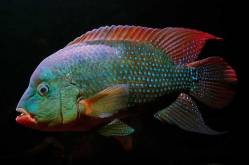
Cichlasoma Festa Breeding
As has already been repeatedly indicated, reproduction is possible only in an allied pair, formed from the fry age. If there is no such pair, you can try to make a pair of unfamiliar fish, separating them from each other with glass, as described above. After a few weeks of such content glass can be removed. Now carefully follow the events in the communal room. As a rule, the female first begins to test the male for strength. They clamp their jaws together to compete. If the female proves stronger, she’ll have to switch partners. If the male is stronger, peace and order ensues. Perhaps they will end up having offspring.
Spawning can be stimulated by changing two volumes of water in one week. Increasing the temperature of the environment to 26 – 28 degrees Celsius, reducing the hardness to 10 °dH. pH-7.
Eggs are laid on a flat stone cleaned by the male. The number of eggs deposited varies from 100 to 1000 eggs. Their number depends on the maturity of producers and the conditions of their maintenance. After about 3-4 days, larvae will appear, which will be transferred by the parents to the pre-dug holes. After another 4-5 days, the fry will swim and begin to feed.
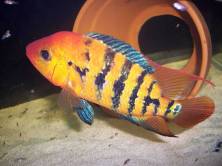
Caring for fry
For the first few days, the fry may feed on mucus produced by the skin glands of the parents. If the pair is formed from the fry age, and the conditions are ideal, the fry can be near the parents until two weeks of age. But it is better to take the rearing of young fish under your control. The fry can be discharged into a nursery tank with a wide hose.
The parameters of the environment of the growing tank should be the same as during the emergence of fry. Starter food – Artemia nauplii. As the fry grow, it should be sorted by size and transferred to larger feed. Starting at about two months of age, you can gradually bring the temperature and hardness of the environment to the usual for adults. The fry are gray with stripes, which change to a more colorful, rich orange coloration as they mature.
Cichlasoma Festa is a very beautiful, but willful fish. To make friends with it is not given to everyone. Difficulties facing the amateur in the maintenance of this species, do not give the opportunity to recommend it to beginners. Although who will distinguish a beginner from a pro? Everything is so conditional…
Go ahead, this wayward pet can bring a lot of joyful moments to its owner.
